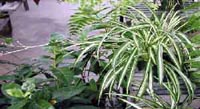Resource Library
Plant of the Week: Spider Plant (Airplane Plant)
The University of Arkansas System Division of Agriculture does not promote, support or recommend plants featured in "Plant of the Week." Please consult your local Extension office for plants suitable for your region.
Plant of the Week
Spider Plant, Airplane Plant
Latin: Chlorophytum comosum

If you adhere to the Hindu notion that all life is a continuum and that the most lowly bug could possibly be an ancestor reborn, then it seems likely that Spider Plant was a cat in a previous life. They have nine lives and when you leave them alone for a while in the dark they fool around and make babies.
Spider plant (Chlorophytum comosum) is a member of the lily family that produces a cluster of foot-long leaves from a crown of fleshy roots. The Victorians called it "ribbon plant," because of its variegated selections. The variegated sort called Vittatum, with a wide central band of white down the center of the leaf, is most common. A variety called Variegatum has a white band down the outer margin of the leaf. Gold variegated forms are also available.
In summer, spider plant produces dime-sized, six-petaled white flowers along sprawling, much-branched scapes that may reach 2 feet long. The flowers are interesting but insignificant.
What makes spider plant unique, is its ability to produce "spiders," or offsets, if you prefer the horticultural term. These ready-made plants, complete with roots, form at the ends of the flower stem and assorted branches.
These dangling plantlets give rise to the common name as they hang below the parent plant like so many spiders suspended by a stout web. The often heard name of Airplane Plant supposes that the plantlets look like whirling propellers.
Spider plant is of South and West African origin and seems to have been introduced into Europe by the end of the 18th century, most likely by the intrepid plant explorer Carl Peter Thunberg(1743-1828). Thunberg, after whom the flowering vine Thunbergia is named, was a student of Linnaeus who traveled in South Africa during 1772 and ‘ 73 where he collected seeds, bulbs and dried plant specimens for his botanical work. Capetown was a popular resting place for ships heading home from China and passengers often took home souvenir plants on their return voyage just as we take home trinkets from our travels.
Spider plant is first and foremost a hanging basket plant. It became popular as such during the Victorian period when decorative foliage plants adorned the parlor of all the finest homes. Flower scapes are produced in the summer with plantlets forming on those stems as the days get shorter in the fall. Of late, spider plant has enjoyed some use as a summer bedding plant where it is used like an annual liriope for edging flower beds.
While spider plants are almost indestructible as a houseplant, they sometimes look a bit tattered and torn. The most common problem is tip burn on the leaves. This is caused by the accumulation of fluoride ions in the tissue until it reaches toxic levels. Affected plants can be cleaned up by trimming the burned tips off with scissors. Unless preventative steps are taken the problem will return.
Plants of the lily family are especially sensitive to high fluoride levels and often show this kind of tip dieback. The fluoride can come from low-grade fertilizer, some vermiculite sources or tap water (for prevention of tooth decay). To remedy the problem, repot the plants in fresh potting soil, fertilize with a high grade liquid fertilizer and, if your community fluoridates its water supply, collect some rain water for this plant.
By: Gerald Klingaman, retired
Extension Horticulturist - Ornamentals
Extension News - February 22, 2002
The University of Arkansas System Division of Agriculture does not maintain lists of retail outlets where these plants can be purchased. Please check your local nursery or other retail outlets to ask about the availability of these plants for your growing area.